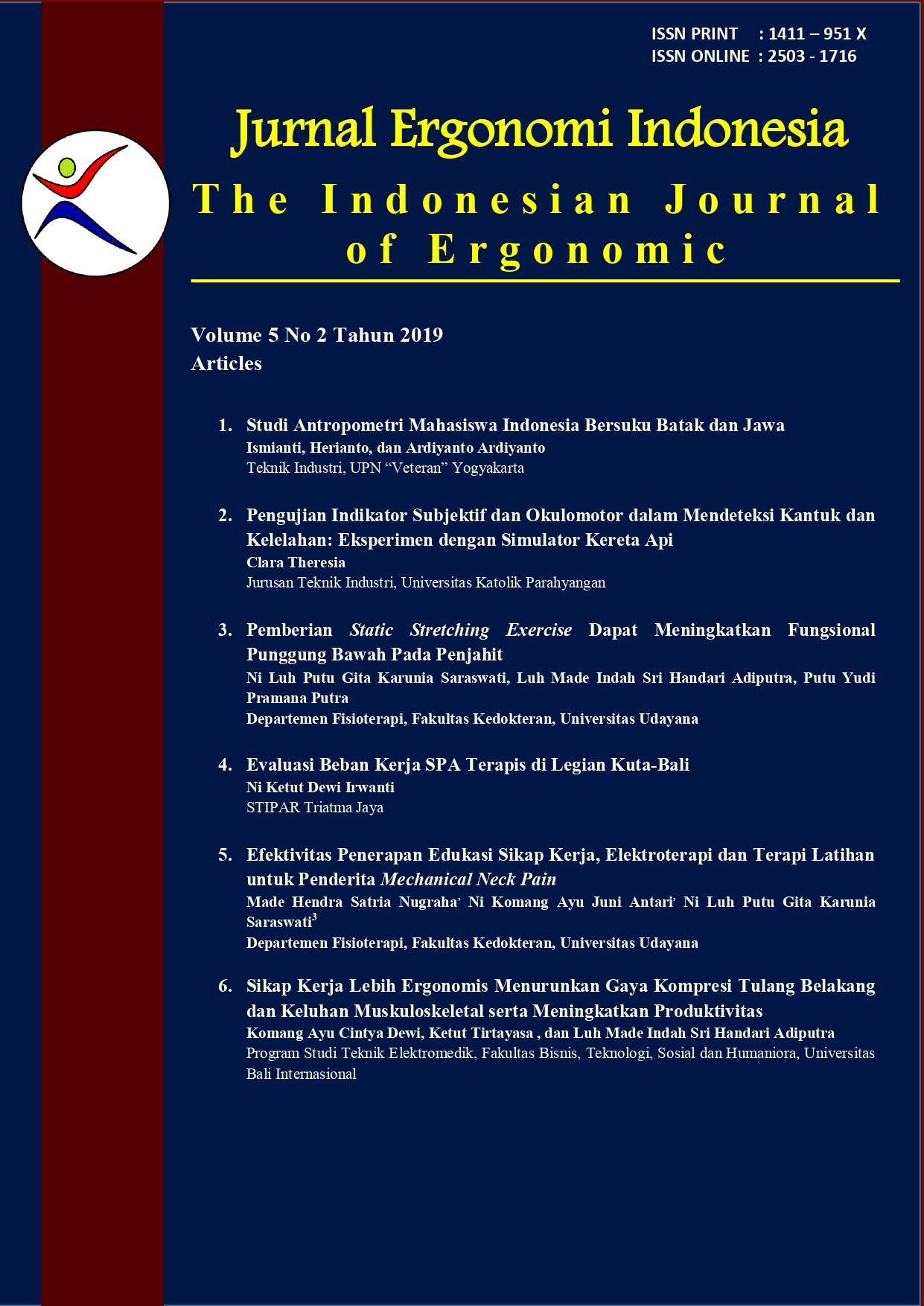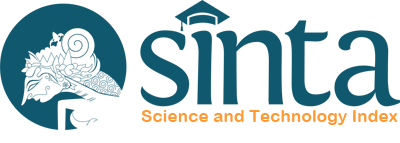Pengujian Indikator Subjektif dan Okulomotor dalam Mendeteksi Kantuk dan Kelelahan: Eksperimen dengan Simulator Kereta Api
Abstrak
Fatigue and drowsiness are factors that contribute to accidents, especially in the transportation sector. A number of subjective and objective measurements can be used as indicators to detect fatigue and sleepiness. This study aims to investigate whether there is a correlation between the Karolinska sleepiness Scale as a subjective indicator of sleepiness and the frequency of blinking as an objective oculomotor. This study involved 12 participants who drove the train simulator for 4 hours. Each participant experienced three treatments of the quantity of sleep the night before the experiment namely extreme sleep conditions (2 h), moderate (4 h) and normal (8 h). Assessment of fatigue and sleepiness used 2 indicators, subjective indicators of sleepiness with the Karolinska Sleepiness Scale and indicators of eye movement in the form of the frequency of blinks per minute of video footage of the camera along the way. The main finding in this study was that there is a strong positive correlation between subjective sleepiness indicators and oculomotor indicators in blink rates per minute, especially for moderate sleep conditions of 4 hours (r=0.861, p=0.013). A strong correlation between the two shows that both subjective and oculomotor can support each other in detecting sleepiness and fatigue. Another finding is that a KSS score larger than 5 occurs after one hour of driving for 2 hours of extreme sleep deprivation and occurs after 160 minutes of driving in a moderate 4 hours sleep condition.
##plugins.generic.usageStats.downloads##
Referensi
Baysari, M. T, Mc Intosh A. S., Wilson, J. R. 2008. Understanding the human factors contribution to railways accidents and incidents in Australia. Accident Analysis Prevention, Vol. 40:1750-1757.
Caffier, P.P., Erdmann, U., Ullsperger, P. 2003. Experimental evaluation of eye-blink parameters as a drowsiness measure. European Journal Applied Physiology, Vol. 89(3-4):319-325.
Craig, A., Tran, Y., Wijesuriya, N. 2011. Psychophysiological Characteristics of Driver Fatigue. In Joris C Verster and Charles F P George (Eds.), Sleep, Sleepiness and Traffic Safety. New York: Nova Science Publishers. pp. 65-91.
Dawson, D., Searle, A. K., Paterson, J. L. 2014. Look before you (s)leep: Evaluating the use of fatigue detection technologies within a fatigue risk management system for the road transport industry. Sleep Medicine Review, Vol.18:141-152.
Dorrian, J., Hussey, F., Dawson, D. 2007. Train driving efficiency and safety: examining the cost of fatigue. Journal of Sleep Research, Vol. 16:1-11. https://www.ncbi.nlm.nih.gov/pubmed/17309757
Dunn, N dan Williamson, A. 2012. Driving monotonous routes in train simulator: the effect of task demand on driving performance and subjective experience. Ergonomics, Vol. 55:997-1008. https://www.tandfonline.com/doi/abs/10.1080/00140139.2012.691994?journalCode=terg20
Iridiastadi, H dan Ikatrinasari, ZF. 2012. Indonesian railway accidents utilizing Human Factors Analysis and Classification system in determining potential contributing factors. Work, Vol. 41(1):4246-4249.
Kaida, K., Takahashi, M., Akerstedt, T., Nakata, A., Otsuka, Y., Haratani, T., Fukusawa, K. 2006. Validation of the karolinska sleepiness scale against performance and EEG variables. Clinical Neurophysiology, Vol. 117(7):1574-1581. https://doi.org/10.1016/j.clinph.2006.03.011
Kim, D.S. dan Yoon, W.C. 2013. Accident causation model for railway industry: application of the model to 80 rail accident investigation reports from the UK. Safety Science. Vol. 60:57-68.
Komite Nasional Keselamatan Transportasi. 2016. Data Investigasi Kecelakaan Perkeretaapian Tahun 2010-2016. Database KNKT, 31 Oktober 2016.
Kosmadopoulos, A., Sargent, C., Zhou, X., Darewent, D., Matthews, R,W., Dawson, D., Roach, G, D. 2017. The efficacy of objective and subjective predictors of driving performance during sleep restriction and circadian misalignment. Accident Analysis and Prevention, Vol. 1(99):445-451.
Kryger, M., Roth, T., Dement, W.C. 2016. Principles and practice of sleep medicine. Sixth Edition. Philadelphia: Elsevier, Chapter 2 pp.19-21.
Lal, S. K. L. dan Craig, A. A. 2001. Critical review of the psychophysiology of driver fatigue, Biological Psychology, Vol. 55:173-194. https://doi.org/10.1016/S0301-0511(00)00085-5
Mahachandra, M., Yassierli, Sutalaksana, I. Z., Suryadi, K. 2011. Sleepiness patern of Indonesian professional driver based on subjective scale and eye closure activity, International Journal of Basic and Applied Sciences, Vol. 11(6):87-96.
Pauly, L., dan Shankar, D. 2015. Detection of Drowsiness based on HOG features and SVM classifiers. Proceedings of IEEE International Conference on Computer Graphics, Vision and Information Security (CGVIS)
Philip, P dan Akerstedt, T. 2006. Transport and industrial safety How they affected by sleepiness and sleep restriction. Sleep Medicine Review, Vol. 10(5):347-356. https://doi.org/10.1016/j.smrv.2006.04.002
Schleicher, R., Galley, N., Briest, S., Galley, N. 2008. Blink and saccades as indicator of fatigue in sleepiness warning: looking tired? Ergonomic, Vol. 51(7):982-1010. https://doi.org/10.1080/00140130701817062
Theresia, C., Iridiastadi, H., Pratama, G.B. 2018. Impact of sleep deprivation on vigilance, fatigue and performance during simulated train driving. Proceedings of the 2nd International Conference on High Performance and Compilation, Computing and Communications. Hong Kong: ACM Publishers, pp 45-50.








